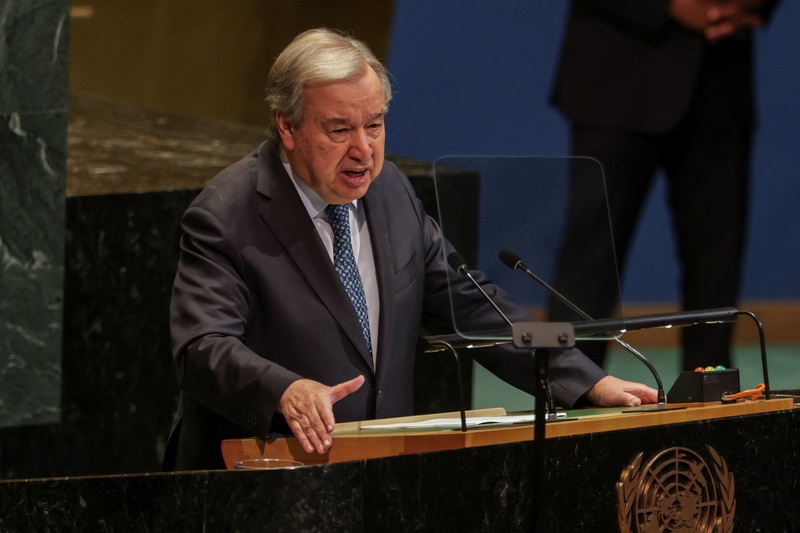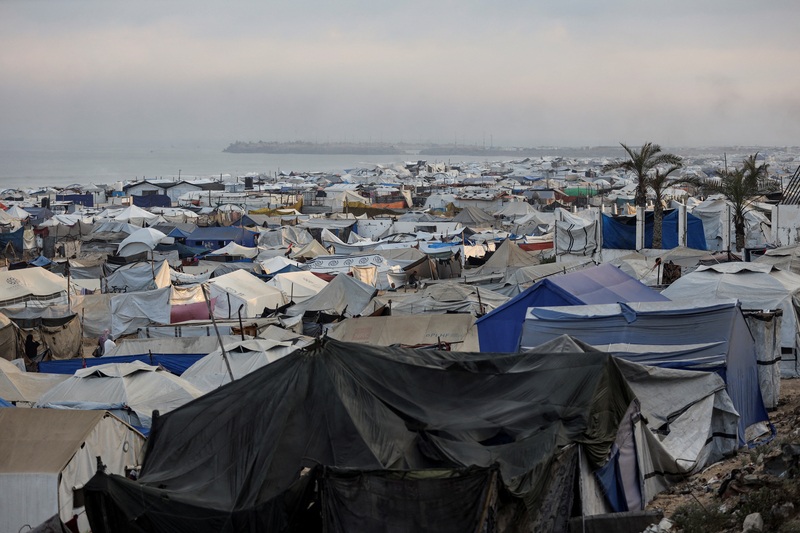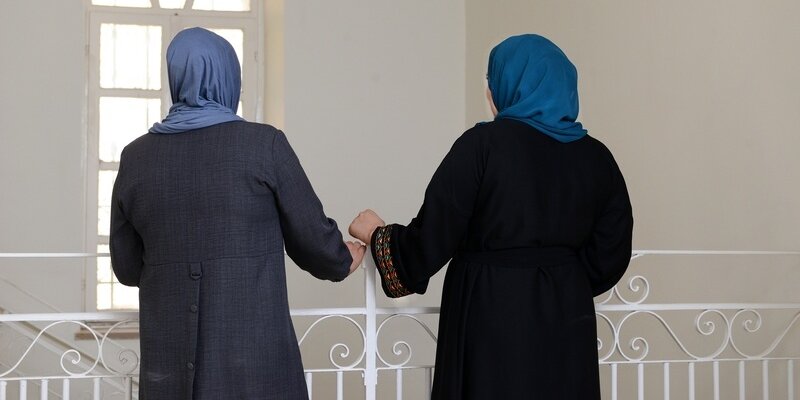Exclusive: UN Publishes Tender for Tens of Thousands of Prefabricated Temporary Units for Gaza
The United Nations Development Programme published a tender to supply tens of thousands of prefabricated, steel-framed units to the Gaza Strip, to house displaced Palestinians. ‘This project will contribute to rehabilitation efforts in the Gaza Strip,’ the UN wrote. The U.N. tender provides a first glimpse into what the “day after" will look like for forcibly displaced Gazans. A Shomrim exclusive


The United Nations Development Programme published a tender to supply tens of thousands of prefabricated, steel-framed units to the Gaza Strip, to house displaced Palestinians. ‘This project will contribute to rehabilitation efforts in the Gaza Strip,’ the UN wrote. The U.N. tender provides a first glimpse into what the “day after" will look like for forcibly displaced Gazans. A Shomrim exclusive

The United Nations Development Programme published a tender to supply tens of thousands of prefabricated, steel-framed units to the Gaza Strip, to house displaced Palestinians. ‘This project will contribute to rehabilitation efforts in the Gaza Strip,’ the UN wrote. The U.N. tender provides a first glimpse into what the “day after" will look like for forcibly displaced Gazans. A Shomrim exclusive
Gazans at a humanitarian aid center, August 2025 (Photo: Reuters), and page from the UN tender

Milan Czerny

Uri Blau
August 20, 2025
Summary


Listen to a Dynamic Summary of the Article
Created using NotebookLM AI tool
Documents obtained by Shomrim reveal that the United Nations Development Programme (UNDP), a U.N. agency, is inviting companies to swiftly bid on a tender to provide up to 45,000 prefabricated steel units, aimed at housing close to two hundred thousand Gazans displaced by the war. It is the first tender of that kind issued since the start of the war, providing a first glimpse into what Gaza might look like once the war ends.
The U.N. plan has far-reaching implications for all parties involved. The documents indicate that progress on the plan will only be possible with Israeli cooperation. Notwithstanding the harsh criticism that Israeli officials have leveled against the U.N. and its various bodies, the Israeli government is expected to work together with the organizations when it comes to long-term housing for displaced Gazans.
As part of the files attached to the tender, the UNDP indicates that it would provide the winning bidder with Israeli approval to deliver the housing units via the border crossings between Israel and the Gaza Strip, as well as coordination with the various bodies operating on the ground to ensure the security of the deployment.
Far from the “Gaza Riviera" promoted by President Trump in AI videos, the tender is soliciting bids for tens of thousands of prefabricated steel units with a 10-year life span, including housing solutions, clinics and educational classes, for use in Gaza.
“The conflict outbreak in Gaza on October 7, 2023, has caused widespread destruction, displacing thousands of families in urgent need of shelter,” reads one of the documents viewed by Shomrim. “This project will contribute to Gaza’s reconstruction efforts and help mitigate the humanitarian impact of the crisis,” it continues, laying out the tender’s purpose, “the goal is to swiftly provide secure, functional, and adaptable housing solutions for families impacted by the conflict; in addition to clinics and educational classes solutions.”
The U.N. plan has aroused great interest in the past weeks among various parties, in Israel and abroad, who see it as the first and most significant sign of the economic fruits that the "day after" plans in Gaza hold, according to a person familiar with the matter.

The tender is an additional sign that the day after the war is actively being prepared for Gaza. Shomrim recently revealed that a Palestinian businessman and former government official from Ramallah could be appointed governor of the Gaza Strip once the war ends.
The tender lays out very strict and detailed conditions for potential bidders. The units are expected to be delivered from the West Bank to Gaza, and the company which will ultimately provide the housing solutions will have to appoint a local contractor with experience in Palestinian territories.
According to the documents, the contracted company is also requested to hire a security guard on the ground in Gaza to secure the site where the units will be installed, and is required to demonstrate a minimum average annual turnover of USD 20 million over the last 5 years. The payment for the company is expected to take place in three steps, with over half of the payment “upon delivery of units to final location in Gaza.”

The U.N. plan has aroused great interest in the past weeks among various parties, in Israel and abroad, who see it as the first and most significant sign of the economic fruits that the "day after" plans in Gaza hold, according to a person familiar with the matter.
A three-year contract
The tender differs from earlier Gaza projects by its long-term scope. Contrary to the current so-called “safe-zones” in Gaza, which are filled with temporary tents, the units would include more long-lasting materials, such as concrete support, and ceramic sinks.
Until now, Israel has barred the entry of housing units into Gaza, citing concerns that the materials could have a dual purpose. In February, Prime Minister Netanyahu blocked the entry of temporary housing into the Gaza Strip despite an agreement to allow it as part of the ceasefire, according to a report by public broadcaster Kan.
The files detail various types of prefabricated modules which are planned to be installed in Gaza; including units with two floor structures, and tens of thousands of 18-square-meter units with bedroom, bathroom, and kitchenette, aimed at housing around 3 inhabitants each. Planned sanitary modules would include two separate toilet compartments, one of which accessible for people with disabilities.

The agreement between the company which will provide the units and the U.N. is expected to run for the coming three years, with the structures required to be designed for a minimum life span of 10 years. The companies bidding must be able to provide up to 75 units on a daily basis.
The tender comes at a time when the IDF is preparing to take over Gaza City, forcibly displacing over one million Gazans. The U.N. agency denied in a statement to Shomrim any connection between the tender and the planned military operation, and explained that it could be a solution deployed at a later stage.
“The referenced tender is intended to be ready with solutions to be deployed as soon as the situation allows, including a potential ceasefire. It is not connected to any Israeli military preparations, displacement plans, or to the so-called “humanitarian city". The United Nations is clear that humanitarian aid must reach people wherever they are, and that anyone displaced must be allowed to return. As part of the UN coordination system, UNDP maintains active engagement with COGAT and CLA on the entry and delivery of humanitarian aid and materials,” UNDP said.
The Coordinator of Government Activities in the Territories (COGAT), which is responsible for liaising with international organizations over getting aid into Gaza, refused to comment on whether it would allow solid structures into Gaza in the near future. It announced in mid-August that it would provide tents and shelters to Palestinians as part of preparations for the IDF’s offensive against Gaza City. Likewise, as part of a bump to the defense budget approved this week by the cabinet, Israel will allocate an additional 1.6 billion shekels ($455 million) for humanitarian aid to Gazans.













